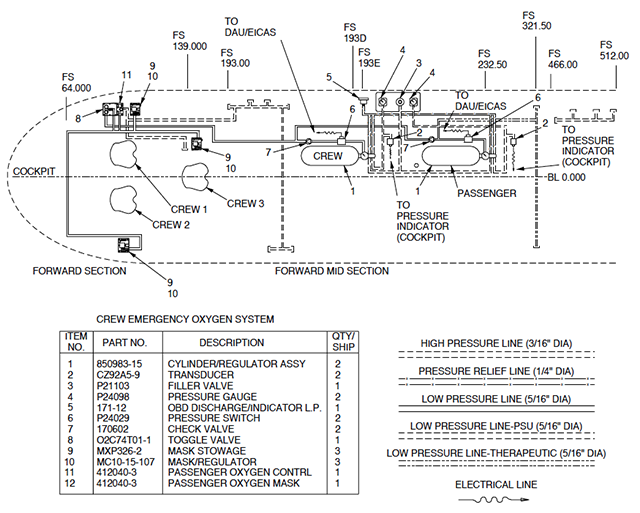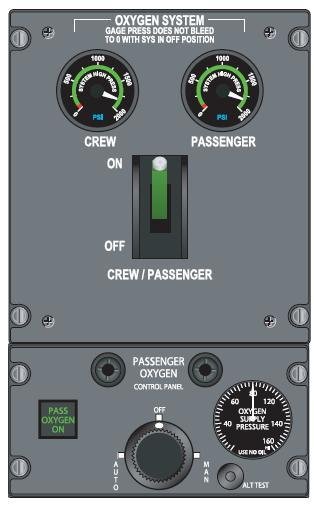Oxygen System
- James Albright (a former G450 driver)
Updated: 2018-07-27
The G450 oxygen system is unique among the GV types, in that the crew and passenger oxygen bottles are plumbed together and can be used by either. The only exception appears to be the therapeutic, which only uses the passenger bottle.
Everything here is from the references shown below, with a few comments in an alternate color.
Oxygen System
[G450 AOM, §2A-35-20 ¶1.] The airplane’s oxygen system incorporates two cylinders or bottles that contain a total of 230 cubic feet of gaseous oxygen pressurized to a nominal 1800 psi. The two bottles are identical and interchangeable, each manufactured from seamless aluminum and coated with Kelvar® fabric to resist rupture. The bottles are designated as crew and passenger supplies, but both bottles are plumbed together into a common supply line just prior to the oxygen system control panel on the copilot side console. Pressure regulators on the bottles reduce system pressure to 55 - 60 psi prior to the supply line to prevent the presence of high pressure flow in the cockpit.
If the tanks are plumbed together why are the pressures sometimes different? I think it is all down to the accuracy of the gauges.
Passenger Oxygen Supply
[G450 AOM, §2A-35-20 ¶2.A.]
Oxygen is delivered to the occupants of the cabin through yellow flexible cup-like masks commonly used in airline operations. The masks are stored in compartments overhead each seat and are deployed either automatically if the cabin is depressurized or through manual command by a switch on the cockpit oxygen control panel. The number of masks installed on the airplane will depend upon the seating configuration chosen by the customer, but will always exceed the number of occupants by at least ten percent (10%) to provide a margin for mask inoperability or for small children not assigned a seat. Masks are also installed in lavatory and galley areas.
Automatic deployment of the masks is signalled by an aneroid sensor that starts oxygen flow to the cabin masks and opens the storage compartment doors if the cabin altitude exceeds fourteen thousand seven hundred fifty feet, plus or minus two hundred fifty feet (14,750 ±250 ft). For automatic deployment to take place, the rotary switch on the PASSENGER section of the oxygen control panel on the copilot side console must be set to the AUTO position. Activation of the passenger oxygen system is signalled by the illumination of the green PASS OXYGEN ON legend within the indicator to the left of the rotary switch. The operating status of the passenger oxygen system is also communicated to MAU #1 and forwarded to the MWS that initiates a CAS message informing the flight crew that the passenger oxygen system is on. When the cabin masks are deployed, a tone or chime is sounded over the airplane’s overhead speaker system and the NO SMOKING signs and/or icons are automatically illuminated. Passengers don the masks by placing them over the face and securing them in place with an elastic band that fits around the head. When the airplane descends to achieve a cabin altitude of thirteen thousand seven hundred fifty feet, plus or minus five hundred feet (13,750 500 ft), oxygen flow to the masks is shut off, since at this level the atmosphere will supply sufficient ambient oxygen for breathing.
What do the masks look like when dropping? Here: Oxygen Mask Drop.
If it is deemed necessary by the flight crew, the passenger masks can be manually deployed by selecting the rotary switch to the MAN position. Mask deployment will be accompanied by the same signals and indications as when automatic deployment occurs.
Cockpit Oxygen Supply
[G450 AOM, §2A-35-20 ¶2.B.]
The cockpit is equipped with oxygen masks for the pilot, copilot and observer positions. A regulator is integrated into the masks to provide on demand oxygen flow that is combined with ambient cabin air, only pure oxygen or positive pressurized pure oxygen flow The masks are stowed in readily accessible compartments and are the quick-donning type that require only one hand to grasp and put in place over the face. The masks are held securely over the nose and mouth by a harness of elastic inflatable tube-type straps. The mask are pulled out of the storage compartment by grasping two red colored plastic tabs on each side of the front of the mask. When the tabs are squeezed, the inflatable tubes are expanded with system oxygen, allowing the mask to be positioned over the head. Once in position, the red tabs are released and the tubes deflate, allowing the elastic of the tubes to hold the mask securely over the face.
A push lever on the right side of the front of the mask is used to select either normal (supplemental) oxygen or a supply of one hundred percent (100%) oxygen to the mask. Normal or one hundred percent (100%) oxygen is furnished on demand - i.e. by normal inhalation.
A rotary knob on the front of the mask can be used to select emergency oxygen that provides a positive pressurized oxygen flow to the mask instead of on demand inhalation.
The masks are certified to a cabin altitude of 40,000 ft and the masks will automatically switch to positive pressurized flow if the cabin altitude exceeds 35,000 ft.
Oxygen System Control Panel
Figure: Oxygen system control panel, from FlightSafety G450 Pilot Training Handbook, page 17-4.
[G450 AOM, §2A-35-20 ¶2.C.] The oxygen system control panel is located on the copilot side console and is divided into two sections. The forward section is labelled OXYGEN SYSTEM, and contains two electrically powered gages that show the amount of oxygen in each crew and passenger bottle, indexed in pounds per square inch (psi). When full, each bottle pressure should read 1800 ±50 psi.
The system selector switch is a toggle switch located below the gages. The switch has two positions: OFF and ON and is labelled CREW / PASSENGER since it controls the flow from both bottles as both are plumbed together. The switch should be selected to the ON position for all flight operations to allow oxygen to be supplied to the flight compartment masks and to the rotary mode control switch for passenger compartment oxygen.
Immediately aft of the OXYGEN SYSTEM panel section is a panel labelled PASSENGER OXYGEN CONTROL PANEL. The panel contains a gage indicating the pressure of the oxygen supplied to the passenger cabin, an annunciator that illuminates the text label PASS OXYGEN ON when the system is in use and a rotary mode control switch to select the type of operation of the passenger oxygen system. The switch has three positions:
OFF to prevent oxygen flow to the cabin,
AUTO to allow the aneroid switch to automatically deploy oxygen masks in the cabin in the event of a depressurization, and
MAN to manually deploy the masks in the cabin.
Pilot’s Oxygen Mask
[G450 AOM, §2A-35-20 ¶2.B.] Pilot oxygen masks are certified to 40,000 feet and will automatically switch to positive pressurized flow at cabin altitudes above 35,000 feet.
Functional Check:
[G450 AOM, §03-03-20, step 41.
Shutoff Control . . . ON
Supply Pressure . . . CHECKED
On the left door of the regulator / mask compartment, press the test button.
Verify oxygen flow to the mask regulator assembly can be heard.
Verify the flow indicator shows yellow momentarily, then black, indicating the regulator is not leaking. If the blinker remains yellow, check for leakage in the system.
While holding the RESET TEST button in the aft position, push the regulator red PRESS TO TEST button in.
Check that the blinker turns yellow and remains yellow for as long as button is depressed.
Release the RESET TEST button.
Check that the blinker returns to black, showing that the regulator demand mechanism is operating properly.
Servicing
[G450 AOM, §2A-35-20 ¶2.E.] The oxygen service panel is located on the airplane’s exterior on the right hand side approximately below the first two cabin windows. The panel is accessible by releasing the locking tabs holding the panel door shut. Within the panel is a direct reading gage for the crew and passenger bottles and a filler adapter. Both bottles are serviced by connecting an oxygen servicing cart to the filler adapter. The bottles are filled by using an ambient temperature vs pressure chart. The nominal full level is 1800 psi at 70°F).
The AFM (G450 AFM, §2-01-20, Step 31) recommends 1,500 psi minimum.
[G450 AOM, §09-02-60 ¶4.B]
Required Quantity
How much do you really need?
Figure: Oxygen duration versus cabin altitude, from G450 AFM, §1-35-10, Figure 1-7.
This is an odd chart in that it is based on less oxygen than you really have and completely forgets about the passengers. You will need to venture beyond your trusty AFM . . .
Figure: Oxygen required for de-pressurization and continued cruise, from G450-OMS-02, Table III.
This chart has caused a lot of problems. Let's say you are planning a long oceanic leg where you don't have the fuel to descend to 15,000 feet if you lose pressurization. So you see this chart and say those masks must be good for extended periods at altitudes up to 25,000 feet. Right? What about the following warning?
[G450 OM, §01-35-20, para; C.] WARNING. PASSENGER MASKS ARE INTENDED FOR USE DURING AN EMERGENCY DESCENT TO AN ALTITUDE NOT REQUIRING SUPPLEMENTAL OXGYEN.
I called Gulfstream about this and was told that this chart was intended for use during test flights where the passengers have the same oxygen masks as the pilots. It isn't meant to mean you can plan on using these masks for cruise flight at altitudes requiring oxygen masks.
The formula for converting a cubic foot to a liter is L = ft3 / 0.035315. Which means you have 6,513 liters total capacity. That isn't exactly what the table shows, but it is pretty close.
You can find a similar chart in the G450 Maintenance / Operational / Placarding Procedures Manual, §35, page 35-2. That chart is for a generic GV and the numbers do not match exactly. The numbers shown here are for the G450 and are slightly lower.
References:
Gulfstream G550 Airplane Flight Manual, Revision 27, July 17, 2008
Gulfstream G450 Aircraft Operating Manual, Revision 35, April 30, 2013.
Gulfstream G450 Maintenance Manual, Revision 18, Dec 12, 2013
Gulfstream G450 Operating Manual Supplement, G450-OMS-02, Extended Operations (ETOPS) Guide, Revision 2, April 2, 2009
Gulfstream GV Maintenance / Operational / Placarding Procedures Manual, Including Aircraft GV-SP (G550/500) and Aircraft GIV-X (G450/350), Revision 8, Nov 7, 2014







